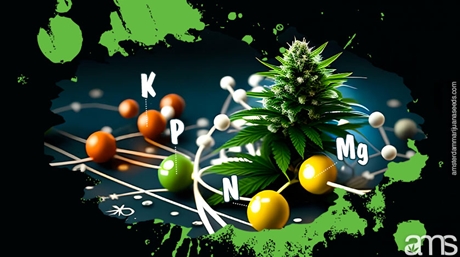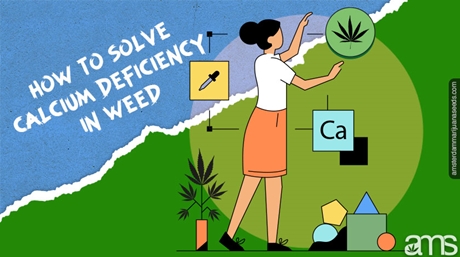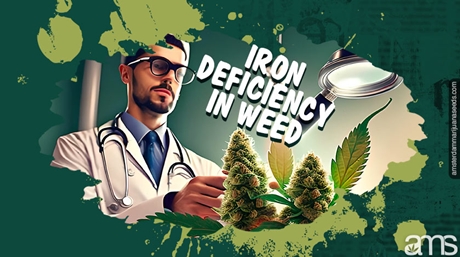Phosphorus is a critical nutrient that is important for plant growth, maturity, and yield. It is part of the three vital nutrients in commercial fertilizers: nitrogen (N) and potassium (K).
Phosphorous (P) is linked to photosynthesis, which helps plants grow and develop normally. It is part of the nuclei, which is responsible for the regulation of protein synthesis.
Phosphorus helps to promote healthy root cannabis growth, early shoot growth, speeds the ground for erosion protection and enhances the quality of fruit, vegetable and grain crops, which is essential to seed formation.
What Phosphorus Does to Ganja Plants
Phosphorus boosts plant growth. Lack of it affects the plants’ produce. Nonetheless, applying or giving your cannabis the recommended dose of phosphorous will help your marijuana a great deal. The following are some of the unique functions of a sufficient amount of phosphorus in your weed:
- First, it gives plants immunity to resist diseases.
- Helps in the development of plants.
- Stimulate root development.
- It helps in crop maturity.
Phosphorus is primarily needed in surplus during the vegetative stage as well as flowering stage. However, oversupplying your marijuana with phosphorus at any given stage would be detrimental to your marijuana.
The importance of phosphorous in weed can well be described in the following stages:
a) Vegetative stage;
In this stage, phosphorus helps in;
- Encouraging root growth.
- Photosynthesis process.
- The formation of sugars, starches, and oils.
- Transformation of solar energy to chemical energy.
b) Flowering stage;
In this stage, phosphorous helps in;
- Helps in transformation of solar and chemical energy.
- Helps in formation of sugar, starches, and oils.
- Photosynthesis process.
- Flower blooming.
Phosphorus uptake in plants is solely dependent on the condition of plant root system. The
following mechanisms help nutrients contact the root surfaces;
- Diffusion: This is the movement through the soil. This is determined mainly by the size of soil particles, moisture levels, and how long it takes to reach the roots. Mass flow: this is the movement of nutrients to root surfaces through the soil water. This is driven by plant transpiration.
- Root interception: this the growth of root structures into soil that comes into contact with
- the plants available. Plant growth is vital due to the additional root surface area for phosphorous uptake.
There are situations where the level of phosphorus content falls in a plant; this is termed as
‘Phosphorous deficiency.’
Phosphorus Deficiency In Weed
Phosphorous deficiency is a disease that causes the plant’s inability to take up any othernutrients. As a result, it reduces the immunity of the marijuana, crop quality, and harvested yield.
It generally appears from the lower parts of the plant.
The lower leaves turn dark green and start getting brown, bronze, and blue spots. The leaves thicken and curl, and the most affected leaves feel stiff. Most times, the stems of the plant turn bright red or purple but not always.
It is important to note that weed needs phosphorus in all growing stages, particularly in budproduction. It also plays a vital role in photosynthesis.
Phosphorous deficiency is predominantly experienced worldwide. This is mainly felt at 82% inthe tropical soils in the western hemisphere.
Causes Of Phosphorus Deficiency
Phosphorus deficiency is caused by inefficient phosphorous in the soil, which affects weed yield. However, the following are contributing causes:
- Lack of fertilizing: – phosphorous is one of the P in NPK fertilizer. Once the soil is not fertilized, it can lead to greater chances of being prone to this deficiency.
- Over-fertilizing: This is an issue as too much phosphorous in the soil can lead to harm than good, affecting the yield. This becomes useless to the soil and the cannabis in general. The effects of overfertilizing will show in other growing problems and nutrient deficiencies. Overfertilizing can quickly lead to PH problems, and nutrients lockout. Overfertilizing is also referred to as nutrient lockout. When plants show the signs that overfertilization has occurred, then it’s essential to reverse it quickly and free up nutrients. Otherwise, they will begin to wither and die.
- A pH imbalance: – phosphorus can only be absorbed when the PH ranges between 6.2 and 7.2. If it lacks this, then there is a greater need to add nutrients in watering. In addition, low temperatures can cause problems since it negatively affects proper absorption of phosphorous.
- Poor soil quality: – the quality of the soil matters in this instance as it can significantly affect the weed yield.
- Loamy or waterlogged soil.
How To Recognize Phosphorus Deficiency in Weed
When a weed contacts phosphorous deficiency, then it is only a matter of time that it’s
Symptoms start to show.
Mainly, the phosphorous concentration falls to a level where growth or yield is negatively impacted; this serves as a visual tool primarily for farmers and researchers.
Symptoms of phosphorous deficiency in weed are:
- Leaves darken and may appear shiny.
- Leaves may start turning yellow in places where phosphorus deficiency is left untreated.
- Leaves get bronze, purple or brown spots and splotches.
- Leaves thicken and may feel dry or stiff.
- Stems turn bright red or purple but not always.
- The deficiency is more common after the buds start forming when the plant uses a lot of phosphorous.
- Bud growth and yield and yield will be low if the phosphorous deficiency sets during the mid-flowering stage.
- In younger plants, phosphorus deficiency leads to slow growth. This underdevelopment leads to a poor root zone.
- When plants lacks vigor and resistance to pests.
Stages Of Phosphorus Deficiency In Weed
These stages are early indicators of phosphorous deficiency in cannabis. They help cannabis farmers/growers to notice and treat it early enough. The following are stages that a plant goes through when infected with phosphorous deficiency, these are:
Early-stage: In this stage, it is the early indictators of phosphorous deficiency in marijuana. The effects are mild and not easily recognizable. These are;
- The weed turns dark green, blue, and gray on the lower side.
- Thickening and spot forming on the lower leaves.
- Yellowing of leaves where spots did not occur.
Middle stage: In this stage, the effects of phosphorus deficiency are seen. These are:
- Twisting and curling of the leaves.
- Mottled patterned leaves.
- Dying of leaf tips.
- Old leaves fall off.
Later stage: in this stage, the following happens to the weed, these are:
- Stem discoloration beginning at the base.
- Twisted or stunted growth.
- Slower growth.
- Abnormal growth.
- Buds not fattening properly.
- Root rot.
How to solve Phosphorus Deficiency in Weed
The following are some of the solutions for phosphorus deficiency in weed:
- Taking good care of the roots; does not mean overwatering as it will not be the solution. However, watering marijuana plants properly is necessary to help prevent phosphorous deficiency.
- Provide the right temperature; the right temperature, in this case, is the room temperature as extreme temperatures show the adverse effects of phosphorous deficiency. The correct pH for the proper growth of marijuana is 6.2 to 7.0, which is required to absorb phosphorous in a soil medium. A pH of 5.5 to 6.2 is necessary to absorb phosphorous in the soil to pass the medium. However, if the PH is outside the ideal range, it is crucial to flush the root system with fresh water. After flushing, it is essential to give the plant ¼ dose of nutrients available to the feeding chart that comes to nutrients. However, the ratio of nutrients is vital to deviate.
- Put the proper nutrients; flush the correct amount of water containing a regular dose of phosphorus, or it is pertinent to completely change the reservoir if excess nutrients might be causing the phosphorous deficiency.
- Taking good care of the roots, phosphorous can be evidenced when the plant is experiencing root problems or if the plant is overwatered, even if the PH levels are right and also phosphorus. Proper watering practices help provide healthy growth of plants, and it avoids a host of problems.
- Please wait for the recovery process; you can wait for a week and see how it behaves. In most cases, the phosphorous deficiency would have cleared up its symptoms. The initial symptoms are brown spots, unhealthy lower leaves; red, purple stems will stop appearing. It is important to note that the already discolored or crumbled older leaves at the bottom do not recover during this period.
How To Prevent Phosphorous Deficiency
Phosphorous deficiency can be prevented in as much as this is usually difficult. The following are the preventative mechanisms:
- The first thing of preventing phosphorous deficiency is identifying the causes and the science behind the same.
- Add more manure to the soil; this helps provide the right amount of phosphorus in the soil.
- Increase the absorption rate by using well aerated soil.
- Utilize the soil with high organic matter.
- Use fungi in the soil to improve phosphorous uptake. This usually helps to turn insoluble phosphate into available molecules.
- Use of technology; in most cases, weed is used for commercial purposes. Due to technology, there has been an advent of technical appliances such as the automating nutrient application eliminating human error. In addition, it ensures proper nutrient dosing every time.
The following are the basic requirements for automation:
- The dosing system; dilutes various nutrients to proper strength and delivers them into the irrigation system.
- Application system; this is where the solution is delivered to the root zone when needed.
- Repeatable method; for the sake of consistency, then the dosing system and application require repeating for optimal plant health and efficient operations.
- Make sure phosphorus is in the fertilizer. Inadequate phosphorus assimilation can lead to its deficiency. Phosphorous is mobile; it moves with ease within a plant to areas with more activity. It is important to note that phosphorous moves from older to younger leaves. The former leaves show chlorosis by the weed turning yellow. The oldest and lowest leaves perform the function of the nutrient reserve, which the plant uses.
- Send the soil to the laboratory to ensure that the soil’s feeding regimen is the most appropriate.
- It is essential to provide the cannabis with the best quality soil and optimal lighting conditions from the beginning.
Classes Of Nutrients
Generally, nutrients are classified into mobile or immobile depending on the translocation levels once fully assimilated by the plant.
- Mobile nutrients: These are stored in older leaves of the plant and can be used to solve the deficiency in other parts of the plant. Mobile nutrient deficiencies show symptoms in older weed leaves at the base of the plant.
- Immobile nutrients remain very close to where they were initially deposited. They show signs of the deficiency in newer growth at the top and outer branches of the plant.
Understanding the whole concept of mobile and immobile nutrients helps to diagnose phosphorus deficiency.
Types Of Nutrients
- Macronutrients; are nutrients that weed requires in large amounts. Examples include; nitrogen, phosphorus (our focus today), and potassium.
- Micronutrients; are nutrients that require in small amounts. Examples include; iron, zinc, Sulphur, and others. These nutrients are so vital in plant growth. Yet, most of the time, they are not needed but cannot do without them. This is the reason that makes it so important.
Effects Of Phosphorous Deficiency In Weed Plant
Phosphorous deficiency has adverse effects compared to positive ones. These are;
- Plant and root impact; in phosphorous deficiency, there is usually a shorter plant height compared to seedlings. In addition, this causes leaves and stems while increasing the ratio of root to shoot.
- Content of mineral nutrients in leaves, stems, and roots; macronutrients decrease phosphorous and nitrogen levels in leaves and stems. Micronutrients, phosphorous deficiency does not change the leaf in size while it falls stem and root.
- Gene expression levels of key channels. This changes the gene expressions in the root, shoot, and leaves.
- Deficiency on antioxidant metabolite contents and activities of antioxidant enzymes. Phosphorous deficiency certainly changes the behavior of the enzymes in the plant.
- Phosphorus deficiency decreases cell division and elongation in grass leaves. Leaf elongation is where the pot plant grows at a low phosphorous, which causes a reduction in phosphorous in the leaf growth area. Cell proliferation is where phosphorous deficiency reduces the cell production rate, that is, the cell flux out of the division zone estimated from leaf elongation and final cell.
- Phosphorus deficiency affects the weed yield that affects its commercial value.
It is important to note that before diagnosing phosphorus deficiency, test the PH levels of water as it varies widely depending on the source.
How To Curb The Spread Of Phosphorus Deficiency
Understating how to resolve phosphorous deficiency in your weed is key. Here are some of the measures you can take to ensure you tackle the problem:
Awareness
It is important to inform weed growers the probable causes of the deficiency, its symptoms and how to solve it. It is important for marijuana growers, to be educated so that they can understand the cons that come with phosphorus deficiency and also how to solve the same.
Research Centers
The world has many research centers. You can find one in your country. Therefore, researchers must provide the means to curb this deficiency. Here, cannabis growers need to invest heavily to stop the same.
Besides, paying attention to how the international community is dealing with it is of utmost importance in handling your weed’s phosphorus deficiency.
Technology
The advent of technology is essential that provides the appropriate solutions to counter this deficiency. There is an important need to embrace technology. We are living in a tech world because of Covid -19 pandemic; now everything is virtual. This is a blessing in disguise.
Marijuana growers now need to take advantage of technology and reduce human errors that are predominant causes of phosphorous deficiency.
Final Thoughts
It is undoubtedly clear that phosphorus deficiency is harmful to the weed plant and has adverse effects.
It is also important to use preventative measures, which are highly recommended than its symptoms.
Phosphorous deficiency significantly affects how pot plant is supposed to function. Therefore, its functionality is essential, primarily how humankind uses it for different purposes.
Phosphorus deficiency should be controlled at every level; if the situation is left, it can bring a lot of bad than good.
It is also crucial for marijuana growers to get sustainable help from the government. The government can help in the awareness of this deficiency, especially in the interior parts of the country where facilities are relatively scarce, to reduce the deficiency levels. The growth of marijuana is essential, primarily when used for medicinal purposes.















